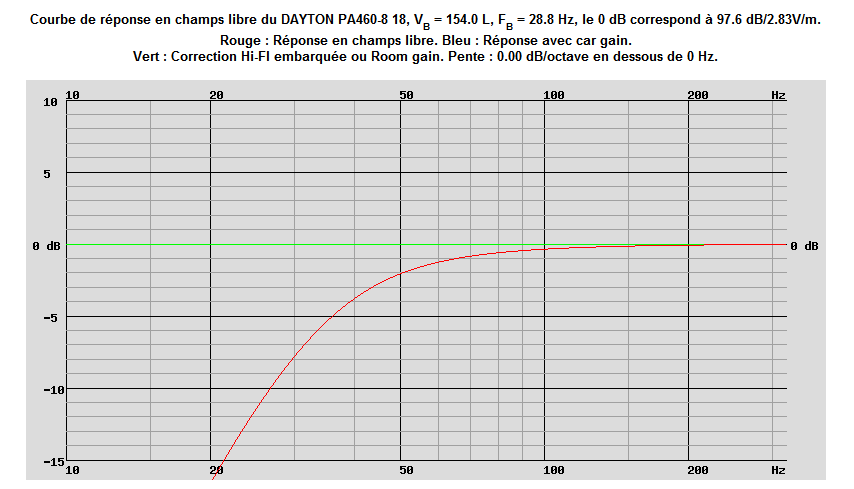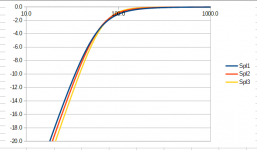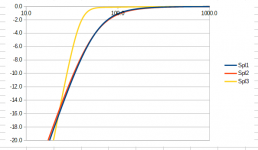Say a typical woofer driver for example a Dayton Audio 18" woofer, which happens to be highly reviewd, very affordable and thus I've bought two, in a sealed box to extend our base a little in a 3 way speaker system. link

Credits thanks to diyAudio community member "Inductor"
The red line in the graph represents the frequency response for the sealed and fully closed enclosude of 154 Liters, right?
Now, what I'm curious about, is how would three other lines show this your graph:
- slightly larger enclosure of say 175 Liters (lets all make this an orange line)
- slightly smaller enclosure or say 125 Liters (lets all make this a pink line)
- much smaller enclosure of 100 Liters (lets all make this a blue line)
- Finally a line for the 100 liters enclosure stuffed with damping materials (brown)
I'm okay if you were to estimate / sketch roughly something in microsoft paint I just want to have a rough idea what happens with the frequency slope of a sealed woofer box, when the speaker enclosure is made larger/smaller
I just want to have a rough idea what happens with the frequency slope of a sealed woofer box, when the speaker enclosure is made larger/smaller 
I hereby invite you all to respond with your own version of the above graphic drawn over it Thank you!
Thank you!
Credits thanks to diyAudio community member "Inductor"
The red line in the graph represents the frequency response for the sealed and fully closed enclosude of 154 Liters, right?
Now, what I'm curious about, is how would three other lines show this your graph:
- slightly larger enclosure of say 175 Liters (lets all make this an orange line)
- slightly smaller enclosure or say 125 Liters (lets all make this a pink line)
- much smaller enclosure of 100 Liters (lets all make this a blue line)
- Finally a line for the 100 liters enclosure stuffed with damping materials (brown)
I'm okay if you were to estimate / sketch roughly something in microsoft paint
I hereby invite you all to respond with your own version of the above graphic drawn over it
As i'm a real fan of 3 way active crossovering systems, I knew that already, but thanks for pointing that out. Independant of equalisation (yess that can always be done to boost something indeed) my question remains:
How will the frequency response line differ when enlarging / reducing the box size?
How will the frequency response line differ when enlarging / reducing the box size?
Last edited:
What size room is this going in and what is your expectation for these? Are you looking for SPL or extension?
I think you will find the PA460-8 limited below 50Hz in sealed enclosures and a medium/large room. Then once DSP/EQ is applied, you may find the output to be lacking a little. Have you looked at the V.B.S.S design?
If your plan is to just reinforce the low-end of some quality speakers for music, then I would look into a PPSL configuration.
I think you will find the PA460-8 limited below 50Hz in sealed enclosures and a medium/large room. Then once DSP/EQ is applied, you may find the output to be lacking a little. Have you looked at the V.B.S.S design?
If your plan is to just reinforce the low-end of some quality speakers for music, then I would look into a PPSL configuration.
I think the answers can be found in one of the simulation softwares, I personally use this one WinISD - Linearteam
This is very straightforward. The larger you make the enclosure, you will get more amplitude below the knee and less amplitude at the knee (shallow rolloff). The smaller you make the enclosure, you will get less amplitude below the knee and more amplitude at the knee (steeper rolloff). F3 will be lowest at some "optimal" enclosure size where Qtc = 0.707.
Dan
Dan
Wouldn't F3 be lowest the biggest the box?F3 will be lowest at some "optimal" enclosure size where Qtc = 0.707.
B.
Wouldn't F3 be lowest the biggest the box?
What do you think 'maximally flat' means?
Just for starters Ron, could you define "maximally flat" for us (and I don't mean Webster dictionary but a quantitative statement)?What do you think 'maximally flat' means?
What makes you think OP wants "maximally flat"* instead of a bigger box resulting in "real great low bass"?
Or maybe he'd be happy with a slightly bigger box resulting in "totally undetectable ripples on the theoretical sim" but "nearly best possible bass extension".
As anybody who has worked with REW much can attest, after a good speaker is installed in a room, the room-ripples are gigantic and the sim-ripples are trivial and undetectable by comparison.
B.
*as previous threads in this forum have shown - and as anybody could intuit on their own - the best sounding bass has a rising loudness; therefore, a sim should "solve" for rising bass in a speaker, not "maximally flat" whatever that means
Last edited:
Just for starters Ron, could you define "maximally flat" for us (and I don't mean Webster dictionary but a quantitative statement)?
What makes you think OP wants "maximally flat"* instead of a bigger box resulting in "real great low bass"?
Or maybe he'd be happy with a slightly bigger box resulting in "totally undetectable ripples on the theoretical sim" but "nearly best possible bass extension".
As anybody who has worked with REW much can attest, after a good speaker is installed in a room, the room-ripples are gigantic and the sim-ripples are trivial and undetectable by comparison.
B.
*as previous threads in this forum have shown - and as anybody could intuit on their own - the best sounding bass has a rising loudness; therefore, a sim should "solve" for rising bass in a speaker, not "maximally flat" whatever that means
Huh?
Just for starters Ron, could you define "maximally flat" for us (and I don't mean Webster dictionary but a quantitative statement)?
What makes you think OP wants "maximally flat"* instead of a bigger box resulting in "real great low bass"?
Or maybe he'd be happy with a slightly bigger box resulting in "totally undetectable ripples on the theoretical sim" but "nearly best possible bass extension".
As anybody who has worked with REW much can attest, after a good speaker is installed in a room, the room-ripples are gigantic and the sim-ripples are trivial and undetectable by comparison.
B.
*as previous threads in this forum have shown - and as anybody could intuit on their own - the best sounding bass has a rising loudness; therefore, a sim should "solve" for rising bass in a speaker, not "maximally flat" whatever that means
__________________
HiFi aspirations since 1957. Currently working on motional feedback again... the final frontier in audio
"Maximally flat" is a defined mathematical construct - a quick google search might help with your confusion.
After 60+ years of searching for the final frontier, you might want to consider switching to a more factually-based design approach, as opposed to relying on selected postings on an internet forum and your intuition. Logical fallacies might make for good forum postings but they tend to confound progress in research.
*A tip - one cannot "solve" for a function characterized by an ill-defined concept like "rising loudness".
The PA460 woofer in question is not really best utilized in a sealed box.
As far as a sealed box, varying sealed box size even +/- 50% won't matter much at all, either in a room or in a simulator.
Here are two examples One shows 154L, 125L (both "lined") and 100L "stuffed" enclosures. All are bunched closely together. Makes little difference.
The other example shows 154L, 175L, lined as above and then the third is a 200L vented enclosure tuned to 35Hz.
As far as a sealed box, varying sealed box size even +/- 50% won't matter much at all, either in a room or in a simulator.
Here are two examples One shows 154L, 125L (both "lined") and 100L "stuffed" enclosures. All are bunched closely together. Makes little difference.
The other example shows 154L, 175L, lined as above and then the third is a 200L vented enclosure tuned to 35Hz.
Attachments
Just for starters Ron, could you define "maximally flat" for us (and I don't mean Webster dictionary but a quantitative statement)?
I can't educate you, I've tried multiple times. Won't spare the time again. Google is your friend.
What makes you think OP wants "maximally flat"* instead of a bigger box resulting in "real great low bass"?
Or maybe he'd be happy with a slightly bigger box resulting in "totally undetectable ripples on the theoretical sim" but "nearly best possible bass extension".
This technique you are using here is called shifting the goalposts.
As anybody who has worked with REW much can attest, after a good speaker is installed in a room, the room-ripples are gigantic and the sim-ripples are trivial and undetectable by comparison.
Amazing, so only REW can reveal this special behavior?
*as previous threads in this forum have shown - and as anybody could intuit on their own - the best sounding bass has a rising loudness; therefore, a sim should "solve" for rising bass in a speaker, not "maximally flat" whatever that means
Such precise, concise thoughts you have
Wouldn't F3 be lowest the biggest the box?
B.
No. -10dB, maybe.
The -3dB point will shift upwards as the Qtc decreases, while the -10dB point will usually decrease. Lower Q = softer "knee".
Chris
I would not describe this driver as a subwoofer it has a Fs that is quite high for a subwoofer, it is more of a classic Bass driver. However it could be pushed into this function as described above this would probably be best done by porting it. How well this will work depends on how large your room is and how you perceive Bass. If porting it I would not choose a classic alignment as these are typically Butterwoth Maximally flat responses and at very low frequency I don't find these integrate well with the room. I would be looking at a slightly overdamped response pushing the port frequency slightly lower. You will still get a lot of group delay from the port but to my ear it will be less noticeably out of time. However if you are looking for the lively "live venue" lots of bass sound then an underdamped response might sound better to you.
For subwoofers (i.e. when you have very good bass extension and are not trying to play physiological tricks to make a speaker sound bigger) I have found that the best sound to my ears is achieved with a Bessel filter.
A Bessel filter is maximally flat in the time domain rather than the amplitude domain (Maximally flat in time domain is called a butter-worth filter). This gives the minimum peaking in the time domain (Group delay) and I find this alignment much easier to match to the room acoustics. It rarely causes booming and integrates giving good bass without exaggerating the response. However it would have to be said that is not what many people are looking for and in some way this is not unreasonable. It is rare that a live music venue has well controlled bass in a amplified concert, so if you want the live amplified concert sound more bass might be more "realistic". Personally I hate many concert venues for exactly this reason.
A maximally flat function is just one that has the fastest rate of rise achievable without any overshoot in the response. Any faster and the function is called under damped because it will overshot then settle back flat (or ring) any slower and it is called over-damped as it could have risen faster without overshooting. These functions are ways of mathematically describing a response curve and were important in the 70s when simulation was very difficult and you wanted to calculate a response curve mathematically (with pen and paper) that would give a predictable response. There is no magic to them they don't magically sound better, they are just predictable and repeatable.
The Bessel function is a much shallower curve in the amplitude domain, I find this works better with the room gain and the lack of peaking in the time domain helps to keep the time alignment of the thump and snap of the drums together.
To this end I would say that both the 3dB and 10dB points are important as if the 3dB point is achieved with a peaky response the 10dB will be higher up and you will loose deep bass and time response in favour of mid bass and possible boom.
For subwoofers (i.e. when you have very good bass extension and are not trying to play physiological tricks to make a speaker sound bigger) I have found that the best sound to my ears is achieved with a Bessel filter.
A Bessel filter is maximally flat in the time domain rather than the amplitude domain (Maximally flat in time domain is called a butter-worth filter). This gives the minimum peaking in the time domain (Group delay) and I find this alignment much easier to match to the room acoustics. It rarely causes booming and integrates giving good bass without exaggerating the response. However it would have to be said that is not what many people are looking for and in some way this is not unreasonable. It is rare that a live music venue has well controlled bass in a amplified concert, so if you want the live amplified concert sound more bass might be more "realistic". Personally I hate many concert venues for exactly this reason.
A maximally flat function is just one that has the fastest rate of rise achievable without any overshoot in the response. Any faster and the function is called under damped because it will overshot then settle back flat (or ring) any slower and it is called over-damped as it could have risen faster without overshooting. These functions are ways of mathematically describing a response curve and were important in the 70s when simulation was very difficult and you wanted to calculate a response curve mathematically (with pen and paper) that would give a predictable response. There is no magic to them they don't magically sound better, they are just predictable and repeatable.
The Bessel function is a much shallower curve in the amplitude domain, I find this works better with the room gain and the lack of peaking in the time domain helps to keep the time alignment of the thump and snap of the drums together.
To this end I would say that both the 3dB and 10dB points are important as if the 3dB point is achieved with a peaky response the 10dB will be higher up and you will loose deep bass and time response in favour of mid bass and possible boom.
I would not...
There's not much left to be said in this thread because gfiandy has pretty much laid out all the issues. Sadly, I suspect it will be a total bear for many to make sense of. Too bad.
I hope everybody in this thread will read your post with the care it deserves because you've addressed 'most everything.
Maybe even Ron E and Doppler9000 will learn something.
Thanks.
B.
- Status
- This old topic is closed. If you want to reopen this topic, contact a moderator using the "Report Post" button.
- Home
- Loudspeakers
- Subwoofers
- WHAT IF its somewhat Smaller? or Larger? Sealed Woofer Box and Frequency Response

